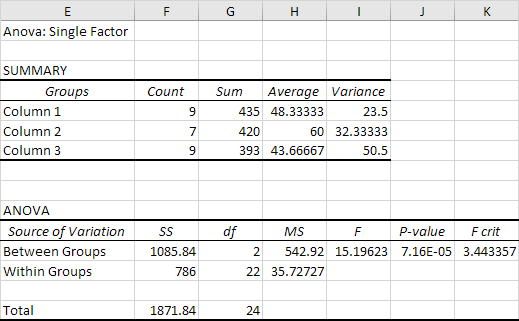

Globally, 34 million individuals are infected with HIV, and currently nearly 14 million worldwide are receiving antiretroviral therapy (ART).
#Topic 4 anova excel worksheet statistical conclusion full
These meta-analysis findings add to the knowledge of acceptance criteria of the Pima CD4 and future POC tests, but implementation and impact will require full costing analysis. The Pima CD4 may be recommended using venous-derived specimens for screening (100 cells/μl) for reflex CrAg screening and for HIV ART eligibility at 350 cells/μl and 500 cells/μl thresholds using both capillary and venous derived specimens. The Pima CD4 was most similar to Beckman Coulter PanLeucogated CD4, Becton Dickinson FACSCalibur and FACSCount, and less similar to Partec CyFlow reference technologies. There was no difference in Pima CD4 misclassification between the meta-analysis data and a population subset of HIV+ ART naïve individuals, nor in misclassification among operator cadres. This increased by 1.2 %, 2.8 % and 1.8 %, respectively, for capillary testing. Total CD4 misclassification is 2.3 % cases at 100 cells/μl, 11.0 % at 350 cells/μl and 9.5 % at 500 cells/μl, due to higher false positive rates which resulted in more patients identified for treatment.

Sensitivity reduced to 86 % (CI 82 % - 89 %) at 100 cells/μl (for Cryptococcal antigen (CrAg) screening), with a significant difference between venous (88 %, CI: 85 % - 91 %) and capillary (79 %, CI: 73 % - 84 %) testing.

Sensitivity of the Pima CD4 is 93 % (95 % confidence interval 91.4 % - 94.9 %) at 350 cells/μl and 96 % (CI 95.2 % - 96.9 %) at 500 cells/μl, with no significant difference between venous and capillary testing. ResultsĪt a median reference CD4 of 383 cells/μl the mean Pima CD4 bias is -23 cells/μl (average bias across all CD4 ranges is 10 % for venous and 15 % for capillary testing). Data were analyzed as categorical (including binary) and numerical (absolute) observations using a bivariate and/or univariate random effects model when appropriate. Primary data (11,803 paired observations) comprised 22 independent studies between 2009–2012 from the Caribbean, Asia, Sub-Saharan Africa, USA and Europe, using 6 laboratory-based reference technologies. A consortium conducted a pooled multi-data technical performance analysis of the Pima CD4. The Alere point-of-care (POC) Pima™ CD4 analyzer allows for decentralized testing and expansion to testing antiretroviral therapy (ART) eligibility.


 0 kommentar(er)
0 kommentar(er)
